Some types of ningyo are defined mostly by a particular shape; they can be made of almost any material and still be recognizable–a tippy, roly-poly doll will always be a Daruma, even if it represents a little girl instead of a powerful monk, or is covered with brocade instead of paint on papier-mache. I look at these shapes on the page for “traditional ningyo shapes.”
Dolls may also be classified by the material they are made of, or specific techniques used to shape the materials. Artisans have developed ways of working with these materials so as to produce dolls so distinctive that they form their own classes and subclasses. On this page I will present some of the construction methods and materials for Japanese dolls of all kinds, and some of the methods which are distinctive enough to be used to classify Japanese dolls.
Range of materials and construction:
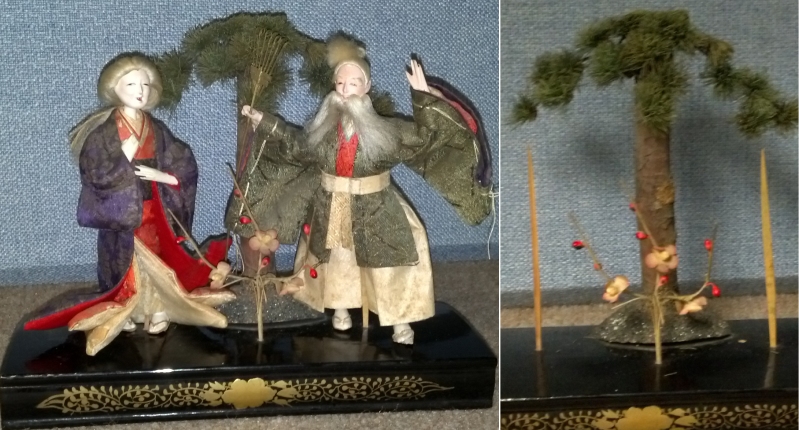
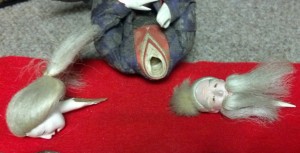
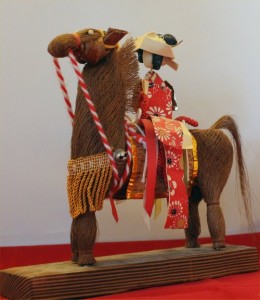
The Japanese will make ningyo of just about any material that is handy. Most of the materials are organic–wood, paper, and other plant materials, cloth and shells. Many traditional dolls are multi-media. Materials that are important, but which I don’t deal with separately here, are straw and reeds (bundled into the right shape to make a body for doll) and wire (to make limbs poseable).
In the creation of hina-type dolls, for example, one set of materials and skills may go into creating the head of a doll: wood-carving, insetting tiny glass eyes, covering the face with gofun “skin” and painting it delicately, and adding and styling a wig. Other skills and materials are involved in creating and tailoring kimono, and in making a body appropriate to the iconography desired. The “stage” for the dolls will require yet a different set of materials and skills, at least carpentry and lacquering, but perhaps also the construction of flowers, trees, animals, or even a miniature gate or room. See the Hina Details page for some useful views of a dairi-bina couple.
Size: Dolls range from over life-size to tiny. keshibina (poppyseed doll) and mamebina (bean doll) are nicknames given to some dolls to evoke their smallness.Iki-ningyo (true-to-life dolls) is a term for life-size dolls (though it may also be used for especially individualized smaller dolls).
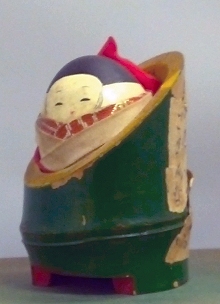
Kiku-Ningyo (Chrysanthemum dolls) are dolls for the Chrysanthemum festival (technically around Sept. 9) consisting of giant flower arrangements! The dolls usually represent legendary figures and may or may not have heads and hands made of a more plastic material. They are life-size or larger.
During World War II, Americans of Japanese descent, interned for the duration, improvised a crocheted hina display for a little girl who would otherwise have gone without.
Another unusual doll material is the eggshell (an emptied but otherwise intact chicken egg). This may be an amateur craft or a souvenir specialty (e.g. of the Toyohashi region), and subjects include samurai, sumo wrestlers (to which the shape is well adapted), or the Moon Princess from the fairy-tale of the Bamboo-Cutter.
Cloth
Although Japanese clothing usually uses up every bit of a woven length of cloth, still scraps might be left over and made into dolls One of the oldest types of ningyo is the hoko, which requires only a rectangle of cloth for body and limbs, a circle to form into a ball for the head, and stuffing; yarn or thread hair is an embellishment.
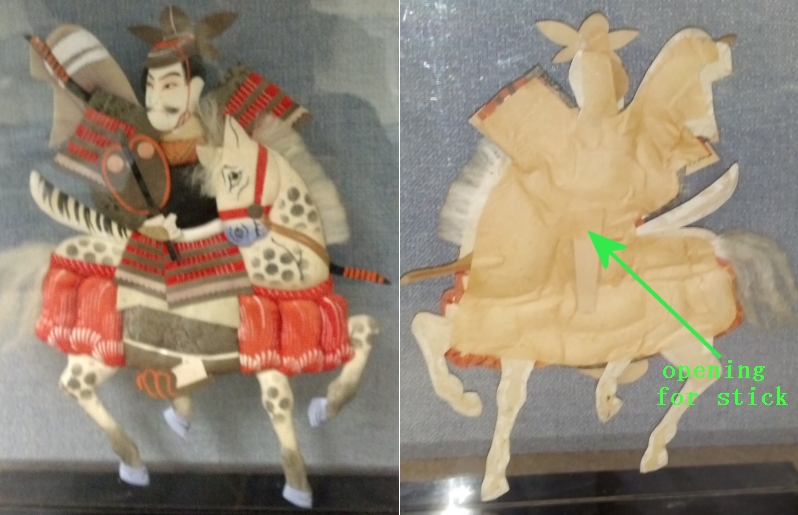
Another type of cloth ningyo is the Oshi-e bina, an almost two-dimensional figure made of overlapping or closely fitted panels covered with padding and silk scraps; the hagoita paddles for New Year’s day are made in this way. In the Meiji period such ningyo representing Kabuki actors and other subjects were very popular, and came with slender sticks attached so that they could be arranged in scenes on the tatami (by pushing the sticks into the matting). Helen Keller was given a doll of this type, representing a child; the overlapping, differently textured and shaped pieces would be fascinating to the touch.
A fabric called chirimen, a kind of silk crepe, which is usually used for under-kimono because of its lightness, is an ideal doll fabric, either for constructing a doll’s body and head or for making clothing. It is both sturdy and flexible, and will follow the form of a stuffing or a construction base. It does not however lend itself to elaborate weaves or dyed patterns, so designs may be painted or embroidered on it.
Other types of dolls feature specially-made brocades or other rich fabrics, scaled to be used in doll-making. Up to the mid-19th century, doll clothing usually was treated as a challenge in beautiful miniature weaving. In the late 19th century and early 20th century, a sort of paper-cloth hybrid was popular to dress cheap hina and “storybook” dolls; it gave the impression of brocade from a distance but did not have the elegance of silk to the eye close up. Late 20th-century hina dolls typically are made with beautiful silk or synthetic fabrics, and they are used in dolls representing actors or other elegant persons.
The dyes used in cloth provide a clue about the date of older dolls. Bright colors are probably produced by chemical dyes, introduced in the last quarter of the 19th century. The older safflower red and indigo blue or green fabrics have a soft quality, fading a little over time; a peek inside a garment often reveals the original color. Black and white were also much used; a particularly rich type of black brocade involved interwoven strands of lacquered paper.
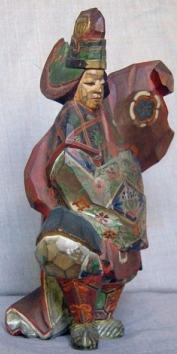
Wood
Some of the most important and oldest regional ningyo are wooden dolls. Dolls which are always carved from solid wood include Saga, Kamo, Nara, and Kokeshi dolls.
- Saga dolls are smoothly carved, sculptural, and usually beautifully painted. This is a very old tradtion, probably derived from Buddhist sculpture, and distinct from it mostly because of the subject matter, e.g. a laughing child holding a puppy. See Alan Pate, “An important 18th Century Saga-Ningyo” for more information on this type of doll.
- Kamo dolls are small figures which probably originated as a temple craft, to be sold to pilgrims as souvenirs. The Kamo doll has relatively smooth forms; the wood is minimally painted, but some cloth may be used to indicate clothing, (making it a primitive form of the kimekomi doll). It represents children or adults engaged in the tasks or festivals of daily life. There is often a comic aspect to the small figures, enhanced by the fact that they are at most a few inches tall.
- The Nara doll is another local craft. It is carved using the itto-bori “one-knife carving” style, which produces a rough, vigorous surface which is usually partly painted (gofun may also be used) but partly left in its natural color. Subjects are frequently the spiritual figures who appear in Noh theatre. Very similar in style to the Nara doll is the Uji or “tea-picker” doll, carved in a similar technique but depicting women dressed as tea-pickers, often with an emphatically red-painted skirt. Nara dolls are usually small, and Uji dolls are never more than a couple of inches high.
- Kokeshi dolls are traditionally made of odd bits of wood turned on a lathe; the faces are minimally indicated with paint, and the “bodies” usually have painted patterns related to good fortune. Like the Nara, Kamo, and Uji dolls, they began as a local craft, sold as souvenirs to pilgrims or health-tourists.
Bamboo was used for one of the earliest doll types, the amagatsu or guardian doll made for a child before its birth; its main part was a cross made by fastening bamboo segments perpendicular to each other, to represent the child’s body and arms. More recently, bamboo dolls are considered more regional, particularly associated with Echizen. Bamboo dolls are constructed entirely of split bamboo segments, usually with little painting and no other materials. A particularly common subject is the Awa Odori or rice-planting dance, with rows of stamping farm women in broad hats. But the bamboo artists may take subjects from more conventional dolls (noh dancers, for example).
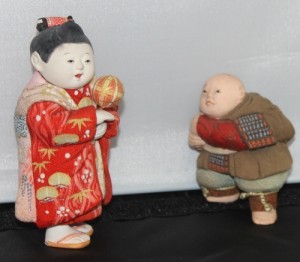
The kimekomi method produces ningyo with glued-on fabric clothing, and a face and hands which can be covered with gofun; sometimes these dolls may have wigs, though in other cases the hair is carved and painted. I include them as wooden dolls because they clearly evolved from the wooden Kamo ningyo. Kimekomi dolls begin with a base of wood, wood composition, or (nowadays) high-quality plastic foam. The artists carve the base into the desired form, including deep grooves in the areas that represent clothing. Bits of cloth are glued onto the base, tucking the edges into the grooves so that the appearance of the “clothing” is of a garment following the contours of the body, or draped in folds. Because of the complexity of the tucking, typically fine silk, e.g. chirimen, of a single color is used, and patterns are painted on.The face and hands may be finished with gofun and paint, often with great individuality and charm. Normally these dolls are limited in size, with larger dolls having simpler and more stylized patterns of grooves. The foam bases, however, allow the creation of larger dolls by master artists.
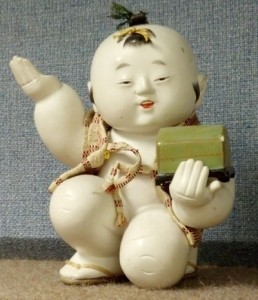
Gofun, the beautiful white paint or lacquer which forms the exposed “skin” of many types of dolls (gosho, kimekomi, hina, ichimatsu, and bunraku puppets). It is usually applied to a wood base. Carved solid wood covered with gofun was used early on, but the wood was likely to expand and contract, cracking the gofun exterior, so a form of wood composition, called toso, was developed to replace it. Gofun is somewhat mysterious, a “professional secret” concocted according to various recipes from rice glue and ground oyster-shells. It must be applied in many thin layers with care to avoid impurities, and buffed repeatedly to obtain the glowing white surface which is so distinctive. Gofun is tinted flesh-color when the person to be represented is either of lower class or meant to be seen as a vigorous, masculine figure; white skin indicates youth, an aristocratic nature, spirituality, and/or refinement.
Paper
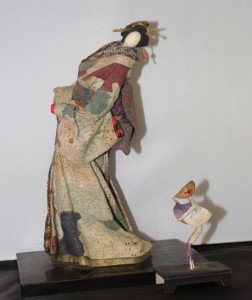
Folded paper figures are at the origin of the Girls’ Day festival (Hina Matsuri), but originally they were not toys; on the third day of the third month (nowadays Hina Matsuri), a special folded paper doll (katashiro or hitogata) could be rubbed on one’s body to purify the soul, and the sins sent sailing on a river or up in smoke. This practice is recorded as already old in before the year 1000, in the Tale of Genji. It is described in various sources in a number of ways, which suggests that there were local variations, and even today the idea of nagashi-bina (casting-away dolls) may evoke a boatload of abandoned hina or a straw nest with a couple of paper figures in it, depending on where one lives.
It seems likely, though, that the dolls with which little girls play in Tale of Genji, and also the dolls which are treasured by ladies in diaries of the Heian era, are at least sometimes made of folded or rolled-up bits of paper. They could be made by women for children or as gifts for each other, but up until the Edo period would probably have been mostly enjoyed by ladies of the imperial court in Kyoto. In this early period the tachi-bina format (a male-female pair with a particular iconography) developed and became associated with the third day of the third month. Later, tachi-bina made of deluxe embossed and even lacquered papers would be provided with little separate spherical heads (on a stick to be inserted into the “shoulders”) and perhaps accessories such as hair, hat, and fan.
Modern dollmakers, such as Kyoko Nakanishi, have developed extremely elegant three-dimensional ningyo using crumpled washi paper. These can form elaborate tableaux representing classical scenes from books or plays, or even history. The paper allows for a more dynamic style of figure than other media.
Origami dolls are still a popular craft. Kits can be purchased at some shops, with beautiful papers cut to the exact size and diagrams for folding.
Papier-maché (harinuki) is an important traditional material, used for example in constructing Daruma dolls, Maneki-neko “beckoning cats”, and the dog toys beloved of small children. It was also used as part of ichimatsu doll construction in some cases, and is used for modern dolls as well. A related material is shiso, a mulberry pulp which can be cast or molded by hand.
Pottery
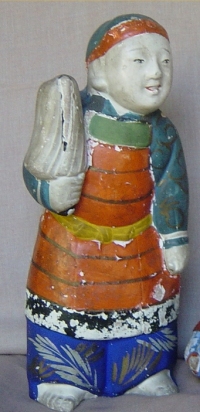
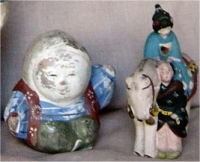
Pottery dolls, tsuchi ningyo, form a large and well-established category. The oldest human figures which have survived from cultures living on the Japanese islands are the pottery Dogu figures of the Jomon culture and the Haniwa, clay figures which guarded the graves of eminent men in the period 300-600 AD. However, as noted above, the guardian dolls of the historical period seem to have been made of bamboo, cloth, or paper, rather than pottery.
In the Edo period, when types of dolls designed for the highest classes were proliferating (gosho, hina, musha, takeda, ichimatsu), pottery provided a cheap alternative. A pottery doll could be molded in one piece and rougly painted, and serve whatever purpose the buyer wished. From the 17th century on, sumptuary law actually restricted the possession of elaborate dolls to certain classes of people (and at least one dollmaker was actually prosecuted for making dolls that fell outside the legal limits); but poor people were allowed to have hina made of “mud.” Such dolls could also be sold to be offered at temples and for other religious purposes.
Hakata dolls.
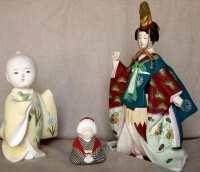
Hakata in Fukuoka Prefecture is the most famous location and “brand name” for pottery dolls. These are unglazed painted dolls which sometimes are mistaken for plaster figures. The finest ones often have a detail in metal, cloth, or wood (a hairpin, cord, etc.) which adds to the vividness of the figure. The Hakata dollmakers produce ningyo of all types (gosho, geisha and kabuki subjects, hina). After World War II, they developed a unique specialty: minutely detailed, often emotionally charged pottery figures representing the various occupations and stages of traditional Japanese life. These were a popular collectible for Americans in Japan in the 1950s.
Pottery lends itself to stylized, sculptural depictions of the human figure, and there was an interplay between a more modern style of Hakata doll and the work of conventional doll-makers such as Hirata Goyo. Some of his dolls from the 50s look as if they were made of clay, while by the 60s and 70s Hakata artist were producing a more romantic style of women and children figures.
Dolls as a home craft
As mentioned above, paper dolls and kimekomi dolls are both available in home craft kits, with all the materials and instructions needed. Simple styles of paper dolls have in fact always been a home craft, though artists have adapted them in various ways.
In his 1955 overview, Japanese Dolls, Tokubei Yamada suggests that in the postwar period amateur dollmakers rivaled the professionals; though they could not manipulate the traditional materials without the intense apprenticeships required of professionals, they discovered new materials, and methods for achieving their vision.
Another type of doll which seems to have developed as a home craft is the sakura ningyo (“cherry blossom doll”), which may also be called a silk-skinned or mask-faced doll. These became popular in the 1920s and 1930s, and were originally made to represent Western film stars (furansu ningyo or “French dolls”). The Japanese versions usually represent traditional “floating world” subjects like kabuki roles or Edo-period women engaged in musical or domestic activities. The kits would include a stiffened cloth mask, sometimes with the face already painted on it, a stuffed body and separate wired arms and legs, and patterns for clothing; accessories could be purchased at the same stores or “schools of doll-making.” The face had to be painted and the clothing assembled; the wired limbs allowed the doll to be posed. After World War II, this type of doll became a favorite souvenir for Americans and they were produced professionally. The art continued to develop with the use of new materials, but the more elaborate doll subjects moved out of the sphere of the home.